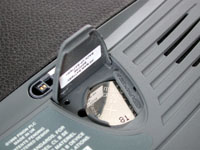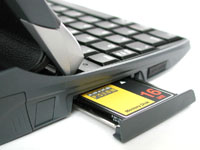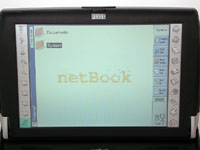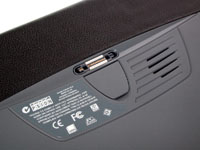|
housing
The netBook is constructed of dark gray
plastic and is wrapped with black leather. Metallic components include
the hinges and the Compactflash (CF) card drawer.

The Psion netBook's housing is both durable
and aesthetically pleasing. It's construction isn't
industrial-strength, but for a large PDA it is surprisingly put together well.
A previous Psion model, the Series 5,
was constructed of a rubber-coated plastic that would begin to
peel after a few months. This does not seem to be an issue with the netBook,
although I've read that the leather can eventually begin to peel at the edges
- my netBook is almost a year old and it shows no signs of peeling.
hinge
Pressing the release button allows the
display to be opened. The large metal hinges on either side of the display's
base securely hold it at the desired angle.

By virtue of the fact that the netBook is of a clamshell form-factor, it requires a hinge. The
hinge can be the most fragile mechanical component of a clamshell device. The netBook seems to have been
designed to maximize the durability of this component. When closed, the hinge is hidden - it is not located
in the back, where it would be more susceptible to damage if dropped. Granted, the netBook's hinge is relatively
complex, but it mainly consists of metal components, which is probably one of the reasons why the netBook is rated
to be able to withstand a 1 meter drop onto a wooden surface.
power
The netBook is powered by a rechargeable
Li-ion battery. It can also be powered by the supplied AC adapter and cables.
A 3 volt lithium backup battery preserves the contents of the netBook's RAM
when neither of the above power sources are present.

The included power supply cables can
power the netBook and recharge the Li-ion battery simultaneously.
The main battery can easily last for more
than 8 hours, or in some cases less than 2 hours. For example, constant use
of a PC card modem and a high display brightness setting will result in the poorest of battery life. Using a
brightness setting of 2 (out of 10) will make a substantial difference in battery life. I find that a level two
brightness setting is sufficient enough in all except bright (direct sun) lighting conditions.

Talking about PC card modems, each
time the netBook is powered-on, the modem is initialized even if it
isn't being used or about to be used. That means the battery life can
be extended if the PC card slot is void
of a modem when the netBook is powered-on and off frequently.
keyboard
The keyboard is both smaller and slightly
laid out differently than a conventional one. It is somewhere between the
Psion Series 5's keyboard and that of a laptop.

See the
Images section for more
keyboard comparisons.
I find the keyboard to be far more
responsive than that of the Series 5. I actually prefer the netBook's keyboard
over the T20's.
stylus
The stylus silo is located on the right side.
It is released by the slider switch found above the Delete key.

The stylus is exactly the same as
that of the Psion Series 5/5mx. It consists of a practical weight, and of a 3-sided,
non-roll design, which prevents it from rolling away from you.
pc card slot
 A type II PC card slot is located on
the right side. It contains a plastic protector when not in use.
This slot is compatible with select modems/Ethernet cards, PC card
adapters, data storage cards, and VGA output cards. If a data card
is inserted, it is recognized as the "E" drive.
A type II PC card slot is located on
the right side. It contains a plastic protector when not in use.
This slot is compatible with select modems/Ethernet cards, PC card
adapters, data storage cards, and VGA output cards. If a data card
is inserted, it is recognized as the "E" drive.
Compatible cards include:
- Psion plastic PC card slot protector
- Sandisk CF type I / PC card adapter
- Microtech CF type II / PC card adapter
- Psion DACOM 56k + Fax 10 Mb Ethernet card &
Psion DACOM V34+Fax Modem
- Sony Memory Stick / PC card adapter
cf card slot
A type II CF card slot is located
on the left side. The CF slot is the "D" drive.

CF memory cards provide a great way
to expand the storage capacity of a netBook. Most CF cards are solid-state, which
gives them the benefits of speed, durability and longevity. Remember, the internal
RAM can be used for both running applications and for storage, whereas CF and
PC cards can merely augment the storage capacity. In addition to
increasing the netBook's storage capacity, CF cards also have the advantage
of being compatible with many other current consumer electronic devices
(or digitalMACHINES, as I like to call them), like digicams and other PDAs.
A CF card can be swapped
 between devices to allow the sharing of files. For example, files can be transferred
between the netBook and a CF card reader-equipped PC.
between devices to allow the sharing of files. For example, files can be transferred
between the netBook and a CF card reader-equipped PC.
Compatible cards include:
- IBM Microdrive 340MB (type II CF)
- Psion/Sandisk 16MB (type I CF)
- Sandisk 64MB (type I CF)
The netBook's CF slot is actually in the
form of a drawer, which unfortunately prevents special I/O CF
cards with extraneous hardware from being used.
The IBM Microdrive is compatible, but less than ideal. The netBook's OS
periodically scans its drives. Since the Microdrive requires time to spin up and then allow the OS to
read its directories, the software appears to slow down considerably. If you want your netBook to run
as fast as possible then the Microdrive is not a feasible option. I merely insert it periodically for
backups. Solid-state CF cards, the type that consist of flash memory, are speedier, but more expensive
and not available in such high capacities.
lcd display
The netBook is capable of displaying
256 colors (8 bit). The LCD uses STN or passive matrix technology. The resolution of the display is
VGA or 640x480 pixels. It is also touch sensitive.

Most laptops and PCs can display
tens of thousands (16 bit) to billions (32 bit) of colors.
Most laptops (and some PDAs) use TFT or active matrix displays. Despite
the drawbacks of it consisting of an older and seemingly inferior technology,
the netBook's LCD does have it's advantages. It requires less
power than a
TFT. The likelihood of it developing stuck pixels is far less as
compared to TFT LCDs. The netBook's display is actually quite colorful and bright.
serial port
The serial port is to the right of the CF slot.
It's maximum speed is 115200 kb/second.

A secondary serial port and power connector
are located on the bottom of the netBook. The optional cradle interfaces with these connectors.
The serial port provides the physical means
for connecting the netBook to a PC for the purpose of backing up
and tranfering files. PsiWin (which is supplied for a Windows PC),
or MacConnect (which is optional for a Mac Computer) provides the software means for
the connection. This connectivity software (at least in terms of PsiWin... I have no experience
with MacConnect) can also perform file
conversions - Psion or EPOC format to/from Windows format.

For a device with this amount of memory
capacity, I feel the netBook should have been equipped with a much quicker PC interface
port. USB (Universal Serial Bus) is a widely used alternative to the serial interface.
USB is faster (somewhere around 4Mb/second), and hot-swappable. One obvious reason
for Psion not to have used USB technology with the netBook is to maintain a certain
amount of backward compatibility. Most, if not all, Psion PDAs use the same serial connector
and cable, and can use the same software (PsiWin). Although, from what I've heard, the
latest version of PsiWin (v 2.3.2) does not support Psion's SIBO* PDAs, so a
chunk of backward compatibility seems to have been lost anyway.
*SIBO is the designation given to an
older operating system from Psion that is used by PDAs such as the
Series 3/3a/3c/3mx and Siena. Psion's current OS is called EPOC. It first appeared in the Series 5.
infrared port

The Infrared port is located on the back corner.
It provides a wireless (although, limited to
a direct-line-of-sight and to a relatively short distance),
serial connection to another compatible infrared equiped device.
Such devices are listed below; they have varying degrees of software compatibilty:
- another EPOC PDA - pretty much full s/w compatibility. Files and data can be transfered without any problem.
- an infrared-equiped Windows PC or laptop - PsiWin is required. Windows2000/NT are infrared-challenged, though.
- an infrared-equiped mobile phone - (see Interfacing w/mobile phone)
- a Palm PDA - (see Interfacing w/Palm PDA)
internal
For processing power, the netBook relies on a
32-bit StrongARM SA-1100 CPU running at 191.692 Mhz.
Internal memory consists of a 32 MB RAM chip and an empty
slot that can hold another 32 MB chip: a 189USD option.
The netBook does not have a ROM, unlike
most PDAs. The OS and stock applications are loaded into the RAM
from a CF card during the initial boot-up (or after a hard reset). As a result, the amount of
available RAM is reduced by about 13 MB, to 19 MB. Moreover, should both the main Li-ion and
backup batteries go dead, the RAM will lose all it's contents. Therefore backing up the data
in RAM is important. The CF card that contains the OS image should be kept close at hand as
well.
A flash-able ROM would probably have
been a more ideal choice for storing the OS. With
the setup as it is, though, the OS can be upgraded easily and the installation of stock applications
is user configurable; the user can choose which stock applications to install.
|